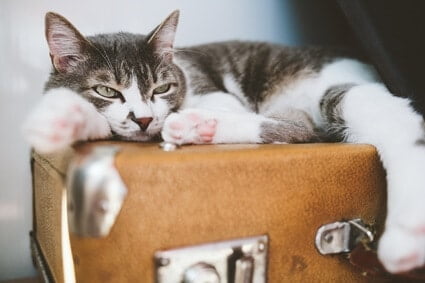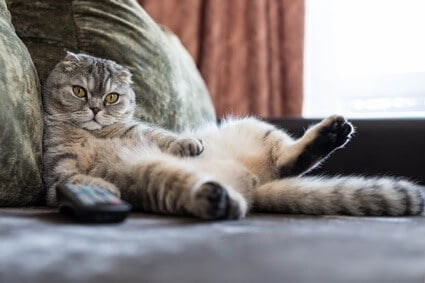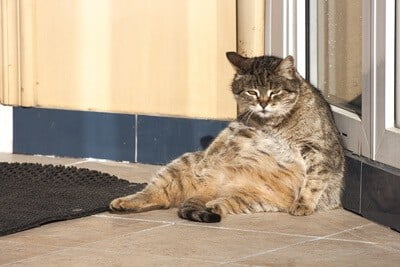As cats grow older, they naturally become less playful. Play is vigorous for a cat, and senior felines don’t have as much energy to spare, and their joints are more likely to be painful. Play remains an important part of a cat’s day, though. For some indoor cats, it’s the only exercise they get all day.
Encourage lazy cats to play by changing up toys. The novelty will always pique a cat’s curiosity more than familiar equipment. Utilize other instincts such as climbing, digging, and hunting. Add tempting scents to toys, such as food or catnip. Check your cat’s diet as it may be lethargic due to inappropriate nutrition for its advancing years.
Most cats can be tempted into play through gentle encouragement. If that does not work, try bribery. Many cats will do anything for a favorite treat. If your cat still refuses to play, rule out a medical explanation for its lethargy.
How To Make Your Lazy Cat Playful
It can be sad when a cat loses interest in toys. Many owners still remember a boisterous kitten when looking at their senior cat. As cats grow older, they become less interested in expending energy on anything non-essential.
Not all cats are naturally inclined toward play. As American Zoologist explains, the feline instinct to play is strongest between 4 weeks and 4 months. At this age, cats play to develop social bonds with littermates.
As cats age, they grow increasingly independent. If your cat did not grow up in a litter, it may never have learned play. This means that you’ll need to convince your cat that play is fun and beneficial.
Play is important to a cat’s physical and mental wellbeing. Play is not just a recreational activity. It simulates hunting in the feline brain, providing the same sense of reward. A cat that does not play may have frustrated hunting instincts. This can lead to problem behaviors, such as bunny kicking.
If your cat prefers to sleep than play, ensure that something else is not amiss. There can be a fine line between laziness and lethargy in cats. If your cat shows any of these behaviors or symptoms, seek medical advice:
- Uncharacteristic aggression
- Loss of appetite and weight loss
- Eliminating outside the litter box
- Difficulty walking
- Clinginess and excessive verbalization
If your cat is healthy but shrugs off play, it is likely just laziness. Some cats will always prioritize sleep over play, especially senior felines. These cats will need encouragement to get involved with toys and games. Thankfully, there are several ways to convince cats to play.

Routine
The simplest way to encourage play in lazy cats is to build it into a routine. Cats are creatures of habit. If your cat expects play at a set time each day, it will accept it. This may be initially grudging. The cat will eventually start to look forward to the activity though.
The key to achieving this is timing the play appropriately. Do not force your cat into it when it would ordinarily be dozing. Cats have a unique interior body clock. The cat will begrudge having a nap delayed for play. Never wake a sleeping cat to enforce play time.
The ideal time for play is shortly after you get home from work, and before eating. This gives you cat time to adjust to your presence. The cat may need to re-adjust to noise in the home after several near-silent hours. Once it is ready, it will be content to engage.
First thing in the morning is also a good slot for cat play. Your cat will be eagerly waiting for you to wake up. It has been expecting food and attention. Play is a great way to provide the latter.
Feeding your cat after playing is important for two reasons. The first is obvious. A cat with a full stomach should not engage in any strenuous physical activity. This leads to the risk of vomiting or regurgitating food.
In addition, food after play will become ingrained in your cat’s mind. Wild cats hunt food, and domesticated cat will feel that they are doing the same. This will also stimulate the cat’s appetite. It will feel that it earned its dinner and thus enjoy both play and food more.
Human Interaction
There are many cat toys that encourage solo play. These can be important if your cat is alone for prolonged periods. Most cats enjoy playtime with a human owner. A play session promises dedicated one-on-one attention.
Cats are independent, not craving human company to the extent of other domestic pets. Cats still enjoy interaction, though. They just like it to be on their terms. This means that you need to get involved in your cat’s playtime.
If you get involved with play, your cat is likelier to respond. As you provide food and petting, your cat will see you as a source of pleasure. If you’re interested in play, the cat will equate the activity with fun. A welcome side effect is an increase in your bond with your cat.
Chasing and hunting games are best for this. Invest in toys on string or a laser pointer. As discussed, these games stimulate hunting instincts. Indoor cats, in particular, may grow lazy as they do not hunt live targets. Play is the next best thing to a moving rodent or bird.
Interactive play is not quite as simple as just dangling a toy. Let your cat capture a toy roughly once every three or four times. If they ‘win’ a game every time, there is no challenge. This becomes dull for the cat. There is no sport in the hunt.
Equally though, a cat must be permitted to capture the toy on occasion. If not, it will grow frustrated and look elsewhere. Cats will not waste energy on a fruitless hunt. If a cat realizes it will not capture live prey, it will seek an easier quarry.
Stimulating Instincts
All cats are unique and place varying emphasis on their instincts. Some cats love to climb, while others like to keep all four paws on the ground. Some cats are natural diggers and scratchers, while others protect their claws jealously.
If your cat appears indifferent to play, you may just be offering the wrong form of toy. Many cats love chasing and hunting games. Your own cat may be looking for different stimulation, though.
Bring cat trees and scratching posts into your cat’s regime. This can be combined with traditional toys. Create a path that involves climbing using a laser pointer, for example. Your cat may quickly realize that chasing the dot up a tree is fun.
You could also make your cat dig up a buried toy. Allow your cat to hunt using its sense of smell or invest in squeaky toys. Senses will fire and your cat will become intrigued. A sandbox can create a fun game for cats.
New and Unique Toys
One of the most important things to consider when playing with cats is variety. Cats grow bored when faced with the same toy over and over.
Applied Animal Behavior Science suggests changing toys every fourth play session. This does not necessarily mean changing the game. Mixing up colors will help a cat to re-engage though. A different scent will also help.
Do not be shy about mixing up the play style, though. If your cat enjoys hunting, mix and match between string toys and laser pointers. Clockwork or electronic toys are also often a winner. Anything that moves seemingly independently can be hunted.
You can also mix up play during a single season. If your cat is older, it will tire faster. This means it will be less inclined to play the same game for a prolonged period. Break a 20-minute play session into multiple, 5-minute games. The cat is likelier to remain engaged.
Adding new and unique scents and sounds to play can also excite a cat. Every now and again, douse a toy with catnip. If your cat is indifferent to this herb, use a food scent. Do not over-use this trick, but it makes something old feel new again when applied sparingly.
Mental Stimulation
Not all cat play needs to be physically demanding. According to the Journal of Feline Medicine and Surgery, many cats enjoy food puzzles.
This is a game that will satisfy a cat’s desire to work for its meal. In the wild, a cat would need to hunt a meal. A domesticated cat will enjoy doing the same.
Food puzzles will obviously not aid a cat’s physical fitness. They can keep an older cat’s mind sharp, though. This is important, as geriatric cats are at an enhanced risk of cognitive decline. The more a cat thinks, the slower the degradation of its critical faculties will become.
In addition, food puzzles can act as a gentle reminder that play can be fun. The cat will receive an immediate reward for interacting. This can encourage the cat to take a more active role in socializing in the future.
Treats and Rewards
Cats live by a simple philosophy. They will only do something they consider worth their while. In the mind of some cats, play with no reward is expending needless energy. That’s energy they may need later. You may need to reward your cat for playing.
Tempt your cat into starting play, and quickly break for a small treat. This may be food or attention. Tailor your approach to what your cat enjoys most. Offer the reward, then re-engage with play. Alternate these activities regularly. Soon, your cat will seek play as it wants the associated reward.
Obviously, you’ll need to be careful with this. Do not keep offering your cat sugary, unhealthy treats. If it is naturally lazy, it will gain more calories than it burns. Small pieces of cooked meat, such as chicken, are best.
In addition, be careful about petting an excited cat. There can be a thin line between engagement and overstimulation in felines. If your cat is too riled up, it may scratch or bite. Practice safety while playing to protect yourself.
If your cat enjoys catnip, this is the greatest reward of all. Offer your cat a hit of this herb once it concludes a playtime. Be warned, though, regular exposure to catnip can cause immunity to its effects. Catnip is best reserved as a high-impact treat, utilized occasionally.
Superior Food
Check the food that you are offering your cat. Reluctance to play could stem from insufficient or inappropriate nutrition. Senior cats, in particular, require specific vitamins and minerals to thrive.
By the time your cat reaches double figures in age, it needs a senior food. Ensure you feed an age-appropriate recipe. This way, your cat will receive everything it needs from a meal. Typically, senior cat food is higher in protein and contains no fillers.
This way, your cat will not have a belly filled with empty calories. The protein found in its food will fuel the cat’s body and brain. As a result, it will be likelier to seek out activity. A cat that feels bloated will just want to doze until it has recovered.

External Stimulation
If you’re struggling to motivate your cat yourself, consider some external stimulation. Do whatever you need to stir up your cat’s instincts.
This could be as simple as opening the curtains. Many cats grow excited watching birds through a window. If your cat starts chirping at birds, hunting instincts are being activated. These need to be redirected somewhere. This is the perfect time to reach for a toy.
You’ll also find a wide array of videos on the internet designed to appeal to feline senses. Play these on your computer or television and they’ll capture your cat’s attention. Once the cat’s blood is up, it will be filled with energy. This can be expelled through a playtime.
You could also try playing music to get your cat’s riled up and ready to play. According to Applied Animal Behavior Science, this must be music designed for felines.
A study found that cats were indifferent to human music, so don’t use your gym playlist. Older cats responded will be species-specific music, though. If your cat is stimulated by sound, it will become more active.
Younger Playmates
A final step could be to introduce a younger, more energetic playmate to your cat. A kitten, for example, will want to play near-constantly. This may encourage your lazy cat to get involved with the games. It could backfire, though. Think carefully before taking this step.
Introducing a kitten to a senior cat can be a lengthy and frustrating process. An older cat will be set in its ways and routines. The introduction of a kitten may lead to conflict. Your older cat may grow jealous of the kitten and the attention it demands. This can lead to domination and bullying.
Your cat may also remain indifferent to play. It will become increasingly frustrated with a boisterous kitten. Kittens lack boundaries. Your cat will be bothered by the kitten until it loses its temper and physically reacts. This can lead to physical injury.
Try everything else before resorting to pairing your cat with a kitten. Some lazy cats will be buoyed and inspired by a new friendship. Just be aware that this is the exception, not the rule. The cats are likelier to initially fight than fall into an immediate, easy dynamic.
All cats start to slow down and lose interest in toys over time. Cats grow up quickly. Too fast for some owner’s liking. Most cats can be convinced to play with the right encouragement, though. Doing so will boost your cat’s health, and the bond between you.

